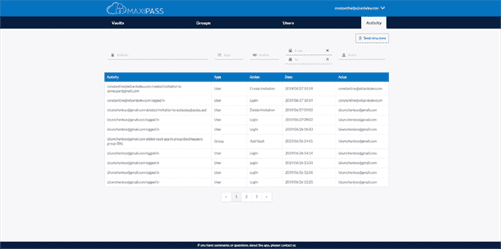The Answer Architect Position And Responsibilities Defined
According to Zippia, 66 % of options architects have a bachelor’s diploma, and 24 % have a grasp’s [3]. A candidate with an MBA in info methods may be a great match for a role as a options architect. The resolution architect role additionally requires with the flexibility to project into the longer term and consider upcoming uses. A options architect must view the long-term use of this product and implement scalability and adaptability into the answer for the lengthy run. Dispelling misconceptions concerning the position of a Solution Architect is a good starting point for gaining a precise understanding of their duties. A widespread misunderstanding is that they’re essentially the most expert developers or experts, extraordinarily adept within the project’s expertise stack.
He directs all product initiatives, worldwide sales and advertising, and enterprise enablement. He has spearheaded the journey in the e-commerce panorama for various businesses in India and the united states However, an answer architect just isn’t involved directly in project improvement. The solution architect ensures the finish result fulfills all the business needs and stakeholders’ necessities.
Job Transient
Their function begins with gathering the requirements, understanding the specs, evaluating the techniques which may be in place, and working intently with stakeholders to deliver the right resolution. The concept of an answer structure is somewhat complex and contains many aspects required to create a custom software program solution with a selected purpose. That’s why there are a quantity of subtypes of structure that handle numerous functional and non-functional necessities and features.
Having a transparent vision for the project and a transparent understanding of the client’s enterprise wants, a options architect maps out the parts that may constitute the software solution and how they will work together. Over the previous decade know-how has transformed business processes, methods, and strategies across various industries. Organizations need to ensure that their core operations are transferred to the most effective tech solutions, otherwise they threat falling behind their competitors.
Now, we hope you may have solutions to all of the solutions architects’ relevant queries and more. If you might have other questions, be at liberty to achieve us, we would be more than pleased to type out your corporation points. When the development staff follows the Agile methodology, the solution http://fresh25.ru/imm42.html architect supports the team, guiding the project on the implementation phase. Simultaneously, they build prototypes to recognize tech limitations or jump onto the product design. Now, we will know what a solution architect does and his roles and responsibilities before and all through the development course of.
What Ought To Be The Most Effective Options Architect Skills?
It is essential for organizations to acknowledge the worth Solutions Architects bring to the desk and offer aggressive compensation packages to attract and retain top talent in this subject. Investing within the expertise of a Solutions Architect isn’t solely a prudent enterprise choice but additionally a testament to the essential role they play in driving technological innovation and success. The wage vary for Solutions Architects varies based mostly on a number of components, including expertise, geographic location, industry, and the complexity of initiatives they undertake. However, it is noteworthy that Solutions Architects are sometimes among the highest-compensated professionals in the IT trade. An extensive comprehension of architectural rules and frameworks similar to TOGAF or Zachman is indispensable for a Solutions Architect.
- We aren’t promoting the product, we are offering them one of the best options they can use to unravel their issues.
- An IT options architect is liable for creating and implementing an IT architecture that satisfies the intended business requirements.
- To decide which IT options would finest serve the company’s objectives, you will want to have a stable understanding of the business as a solutions architect.
- As businesses more and more rely on complicated IT techniques and digital transformation, the demand for skilled Solutions Architects continues to surge.
- An extensive comprehension of architectural rules and frameworks such as TOGAF or Zachman is indispensable for a Solutions Architect.
- Or we will say, as per the time’s demand, companies must run the digital transformation of their primary operations of transferring core processes to software options efficiently.
Businesses who want help with mobile app improvement can rent an application solutions architect. It additionally requires clear communication abilities and the flexibility to translate technical particulars of the project into easy language that shall be easy for non-technical stakeholders to grasp. Successful options architects are often curious, rational, analytical, and methodical—all of which are important traits for this job. Software structure and techniques built-in into it are quite a few particulars that work collectively. An architect needs to be very attentive to these particulars, as overlooking something may hinder the event process, result in breakdowns, or make the software resolution inefficient. They also should be ready to perceive the technical specifications of many different software program options and hardware and perform analysis of various enterprise layers.
They should be business-minded and able to identifying the most effective resolution at each turn for each a half of the architecture. It is their duty to focus on enterprise targets, including hiring new individuals, and understand the method to achieve them within the set timeframe and inside the given budget. Being in a place to talk effectively with stakeholders, project managers, builders, and software program vendors involved in the software program development process is essential for a options architect. As an architect has a central role in any project and leads every group on it, ineffective communication can result in huge bottlenecks. So, this specialist should be ready to clearly explain, perceive everyone’s point of view, listen, advise, and influence. While a solution architect doesn’t immediately get entangled in project management, accounting for deadlines and given resources is inevitable.
Understanding these scenarios’ complexity and potential impact makes it clear why and when a corporation might need to hire an IT Solution Architect. So, such constraints could significantly modify the product, affecting its time to market and price. If you have to launch a streaming service app, you need to maintain the content licenses and copyrights. Every project comes with constraints that can be time risks, cash, and licensing. Every project has a constraint that keeps various from one type of project to the opposite.
A Solutions Architect must command these expertise to make sure the successful and timely delivery of initiatives. They delve deep into specific expertise disciplines, cloud computing, information centers, or cybersecurity. Their proficiency lies in designing, implementing, and troubleshooting within their domain of experience. [newline]The Technical Architect’s position is extra granular, working throughout the framework laid down by the Enterprise Architect, specializing in how specific applied sciences can be applied to attain that overarching imaginative and prescient. This person needs to make certain that the model new resolution matches into the present enterprise structure from technical, business, user, and different views. In some companies, the roles of a ‘solutions architect’, ‘enterprise architect’, and ‘technical architect’ can overlap. An effective solutions architect must possess robust management and communication expertise together with the technical and business knowledge to properly align IT solutions with business objectives.
Google Cloud Architect Certification
We are immersed in an period where a stable software infrastructure forms the bedrock of business survival and expansion in today’s market. Consequently, companies worldwide acknowledge the necessity to embrace digital transformation, leveraging revolutionary and superior software program to bolster their initiatives and gasoline development. As the job title implies, this specialist primarily focuses on solution-level decisions and evaluation of their influence on a client’s overarching business objectives and outcomes.
An architect have to be capable of analyzing and figuring out potential quick and long-term risks which will trigger technical points and impede enterprise operations sooner or later. Before we dive into the subject, let’s clarify who’s a solutions architect in general. A solution architect will fit your product needs with the most effective ways to implement them whereas explaining every little thing clearly in accordance with the business phrases. Entry-level employees make an average of about $76,000 a 12 months, with reported incomes ranging from $75,000 to $160,000. Other than this, if you’re developing a live music streaming app like Spotify, you have to have a legitimate license and copyrights. Also, the method will take sufficient mobile app growth cost, so make your maintain the specified price range for a similar.
Don’t hesitate to get in contact with us to get the top-quality, effective, and cost-efficient solution from our resolution architects and different software improvement professionals working here at Intellectsoft. To successfully design, create, and lead the development of a software resolution, an architect must have a certain talent set. Let’s take a extra in-depth look at the most important skills of a solutions architect beneath. If you might have already realized the significance of answer structure in your projects, the next step is to supply and rent the individual for the role. This is the place the power to clarify advanced and abstract technical ideas is essential for these professionals.
Anyone making use of for the position of a Solutions Architect place will have to have a certain set of abilities, training, certifications and relevant work expertise. Solutions Architects become involved in a project when it’s still in its early stages. They first determine a business’ ache points, then they have a glance at what is required to unravel the problem, after which they ask the shopper about what outcomes they hope to attain. Any enterprise wants that specify the practical requirements of the software are met right here. After that, they pass on their tech imaginative and prescient to their improvement staff, who subsequent begins their work.
The Roles & Duties Of An Answer Architect
Once the SA has created the structure it’s time to speak and promote it. The final part to the role of solution architect is the motivation and guidance of the development leads. Development leaders want to buy into and accept the architecture, to understand how the pieces will fit collectively at a excessive stage.
Enterprise Architect Vs Resolution Architect And The Way They Are Totally Different From The Technical Architect
As a result the SA function comes with a requisite level of accountability for the success of the project. Another method to turning into a SA is to turn into a distinguished Development Lead (DL). The SA ability set is slightly broader and requires a bit more finesse, nevertheless, basically the identical.
Familiarity with DevOps practices like continuous integration, continuous supply (CI/CD), and infrastructure as code (IaC) is pivotal within the present software improvement and deployment panorama. Experience with tools like Jenkins, Docker, and Kubernetes is crucial to streamline and automate improvement processes. In abstract, the Enterprise Architect maps the technique, the Solutions Architect interprets this strategy into concrete options, and the Technical Architect applies specific technologies to make these options a actuality. Each function is distinct yet interdependent, making a harmonious trinity that guides an organization’s technology strategy from imaginative and prescient to execution. This certification targets professionals of different ranges of seniority who work with AWS technologies while creating apps and techniques. The exam lasts a hundred thirty minutes and requires a registration fee, relying on the exam kind.







